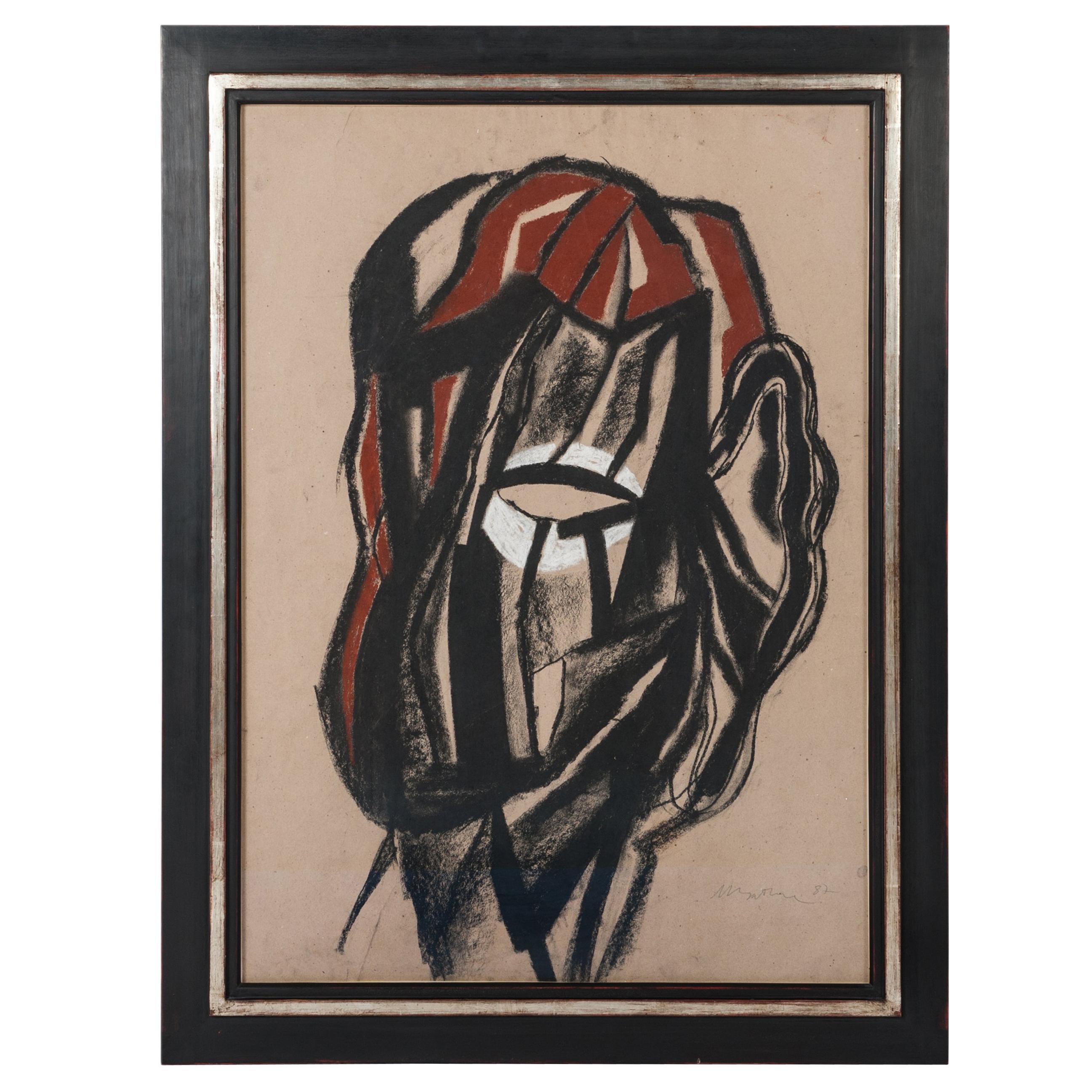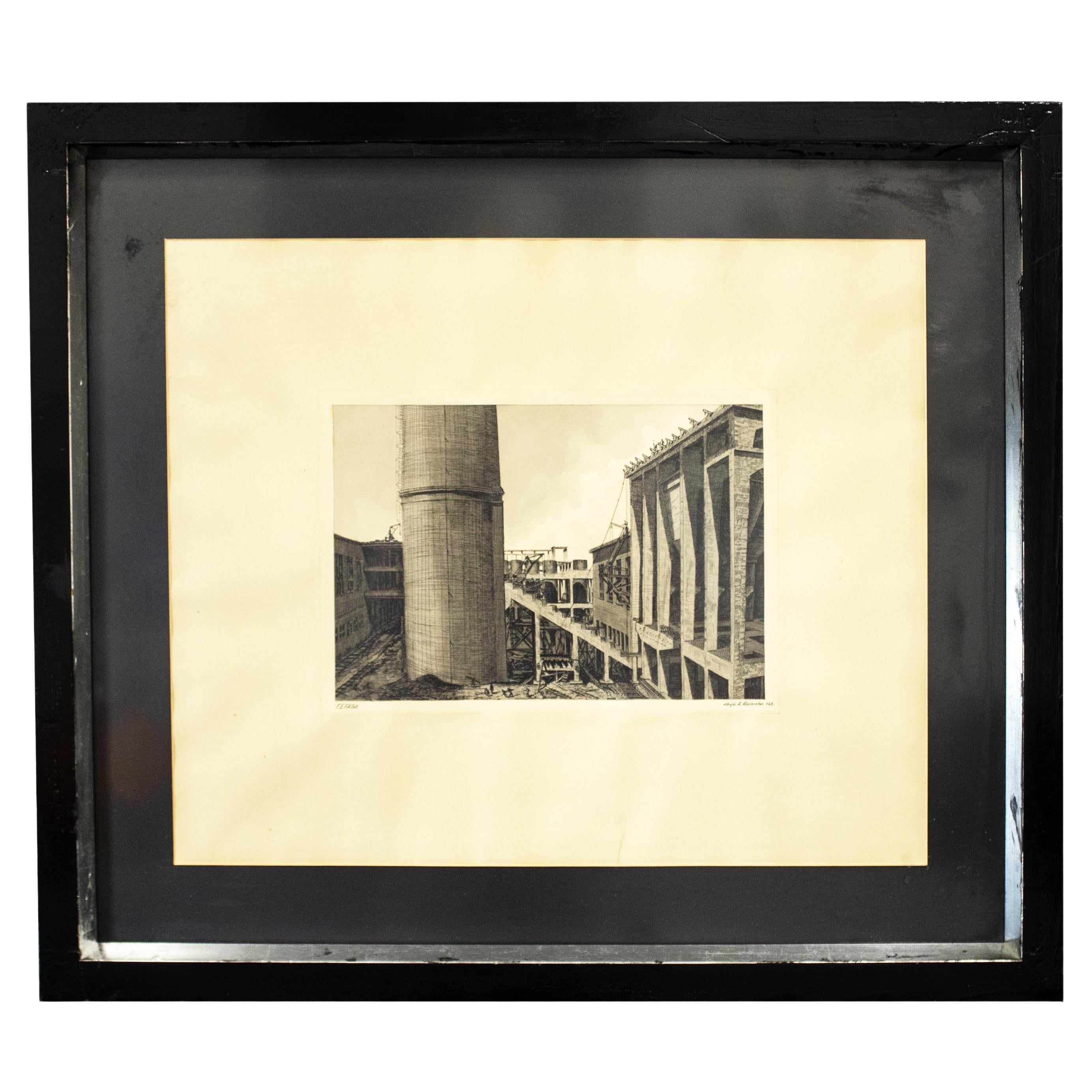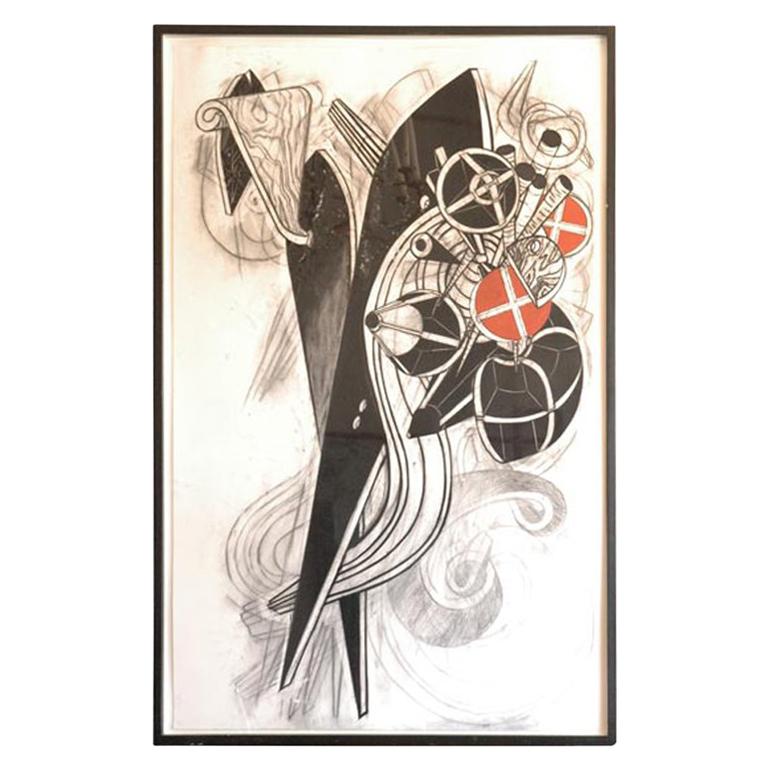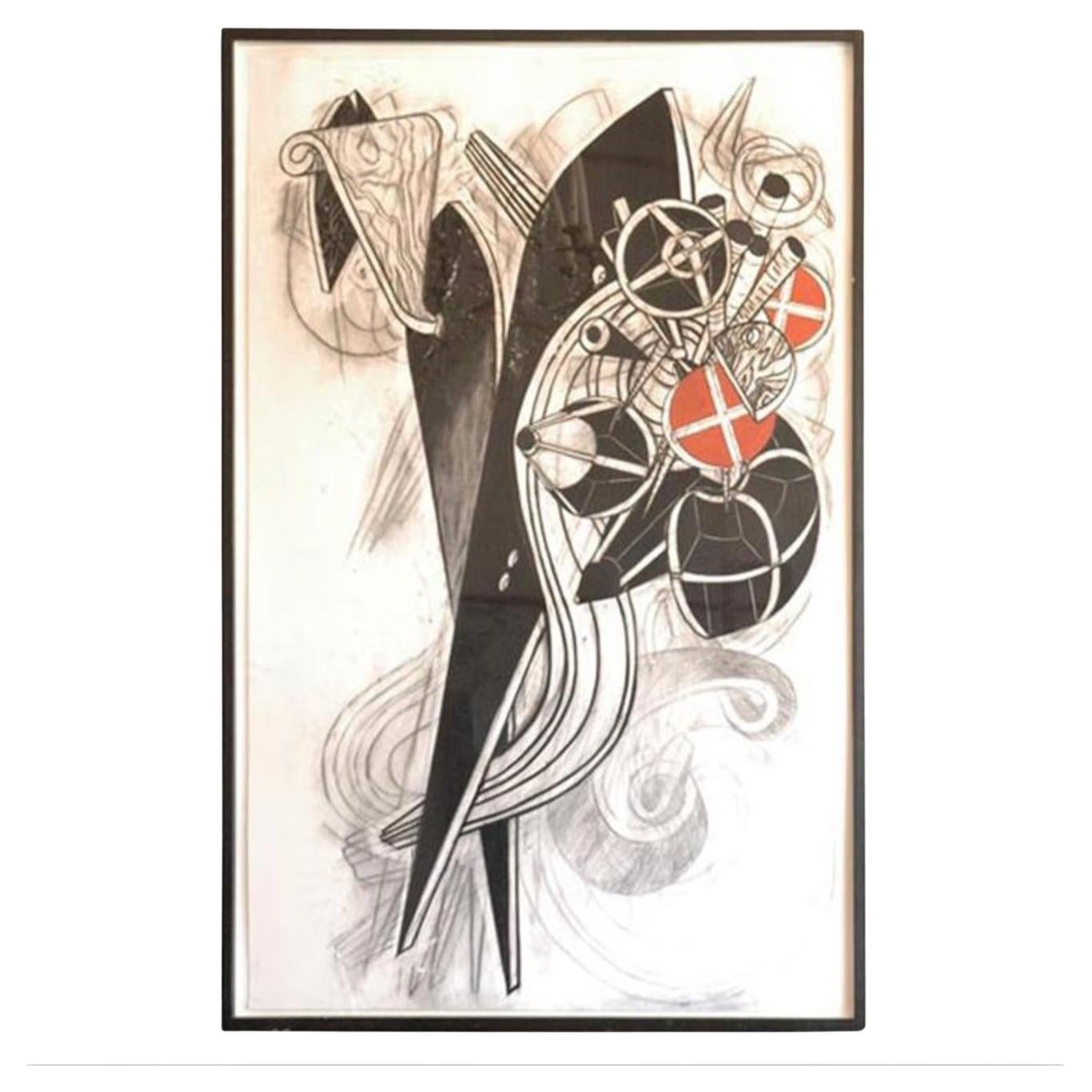Items Similar to Drawing by Manuel Viana, Lithography in Black and White, Limited Edition
Want more images or videos?
Request additional images or videos from the seller
1 of 6
Drawing by Manuel Viana, Lithography in Black and White, Limited Edition
About the Item
Drawing by Manuel Viana, lithography in black and white, limited edition 135/300 signed
Handcrafted wooden frame with white gilt decoration, non-reflecting glass
Biography:
The artist was born in Lisbon, Portugal, in 1928, he died in the same city in 1998.
He attended the Drawing and Painting Courses at the SNBA in Lisbon.
In 1968 he is awarded with the 1st Prize of Painting in the 14th Autumn Hall of Estoril.
In 1972, Manuel Viana excelled in several activities, such as illustration for the press as well as the decoration of murals. He was also a publicist and set designer for the Teatro de Revista.
In 1973, he settled in Paris where he remained until 1986.
Manuel Viana held his first solo exhibition in 1976 at the Maison des Jeunes et de la Culture at the Theater de Colombes in Colombe, France. He exhibited in important galleries in Europe (France, Luxembourg, Yugoslavia, Sweden) as well as in Japan and several cities in Brazil. Manuel Viana is represented in numerous national and international collections, as well as in important museums.
- Creator:Manuel Viana (Painter)
- Dimensions:Height: 31.5 in (80 cm)Width: 38.98 in (99 cm)Depth: 1.78 in (4.5 cm)
- Style:Modern (Of the Period)
- Materials and Techniques:
- Place of Origin:
- Period:
- Date of Manufacture:1979
- Condition:
- Seller Location:Salzburg, AT
- Reference Number:1stDibs: LU2438310109343

About the Seller
5.0
Vetted Seller
These experienced sellers undergo a comprehensive evaluation by our team of in-house experts.
Established in 2000
1stDibs seller since 2016
71 sales on 1stDibs
Typical response time: 1 hour
- ShippingRetrieving quote...Ships From: Salzburg, Austria
- Return PolicyA return for this item may be initiated within 7 days of delivery.
More From This SellerView All
- Charcoal Drawing Black, Beige, Red and White Michel Batlle 1987 Handworked FrameBy Michel BatlleLocated in Salzburg, ATPolyphem: Charcoal abstract, figurative drawing in black-red-white color on beige paper from Michel Batlle, signed 1987 Handworked frame, with white-gilded decoration, non-reflecting...Category
Vintage 1980s French Modern Drawings
MaterialsGlass, Wood, Paper
- Charcoal Drawing Black-Beige Michel Batlle 1987 Handworked Frame, Museums GlassBy Michel BatlleLocated in Salzburg, ATDisguise: Charcoal abstract, figurative drawing in black color on beige paper from Michel Batlle, signed 1987 Handworked frame, with wihite-gilded decoration, non-reflecting museums glass...Category
Vintage 1980s French Modern Drawings
MaterialsGlass, Wood, Paper
- Pair of Abstract Collages Brown-Black Monogrammed and Dated Norbert Krabbe, 1997Located in Salzburg, ATPair of collages monogrammed and dated Norbert Krabbe 1997. Handmade frame, mounted as in the showcase. Norbert Krabbe (1951 Demmin, lives since 2005 in Koserow) is an artistic...Category
1990s German Modern Decorative Art
MaterialsWood, Paper
- Abstract Scandinavian Painting, Warercolor & Acrylic on Paper by Jens BirkemoseBy Jens BirkemoseLocated in Salzburg, ATAmazing contemporary painting, in blueish-turquois-red-black, harmonic composition. Signed by a great "B" in the right corner. Large format, black handworked frame, covered with plex...Category
Vintage 1980s Danish Scandinavian Modern Drawings
MaterialsAcrylic
- Abstract Geometric Graphic in Blue, Red and Black Ink on Paper by A. Luiz PizaBy Arthur Luiz PizaLocated in Salzburg, ATAbstract, geometric graphic in blue, red and black ink on paper by Arthur Luiz Piza. His style combines drawing and graphic techniques. Handcrafted wooden frame black patinated with ...Category
Vintage 1980s French Modern Drawings
MaterialsGlass, Wood, Paper
- Abstract Painting Acryl on Canvas in Black-Grey-White by Guillermo Aritza 1991By Guillermo AriztaLocated in Salzburg, ATModern abstract painting in black and white colors signed on backside Guillermo Aritza, black shadow gap frame silvered on front view. Born 1949 in Mexico, living since 1985 in Paris...Category
1990s French Modern Paintings
MaterialsCanvas, Wood
You May Also Like
- Eagle Bust Signed Limited Edition Original Lithograph by Robert BatemanLocated in North Hollywood, CAVigilance Prestige Limited Edition, October 1993, eagle bust signed limited edition original lithograph, hand signed and numbered by Robert Bateman. pa...Category
Late 20th Century Expressionist Drawings
MaterialsPaper
- Artistic Drawing in Charcoal and Graphite by Adolfo Almarcha, Spain, 1978Located in Madrid, ESArtistic drawing in charcoal and graphite on paper, by Adolfo Almarcha (Burgos, Spain 1953). Project about the paper industry "F.E.F.A.S.A". The Frame is made of black lacquered woo...Category
Vintage 1970s Spanish Drawings
MaterialsGlass, Paper, Wood
- Italian Modern Black and White Artwork on Glass by Tarantino, 1983By Paul A. TarantinoLocated in MIlano, ITItalian modern black and white artwork on glass with wooden frame by Tarantino, 1983. Work on glass with black background and satin design depicting an expanse of water and a waning...Category
Vintage 1980s Italian Modern Decorative Art
MaterialsGlass, Wood
- Large Charcoal and Vermilion Pastel Drawing by John MontiBy John MontiLocated in Los Angeles, CAStunning abstract composition by John Monti. John Monti (1957-) is one of the upcoming "undiscovered" artists of his generation. This piece, dated 1987, belongs to his early period. John Monti has exhibited regularly in New York since the mid-1980s. Against a fluctuating backdrop of stylistic convulsion he has single-mindedly pursued his own ideas. Monti's work is ingeniously devised and fabricated. His earliest wood sculptures, suggesting unlikely mergers of Constructivism and West African...Category
Late 20th Century American Drawings
MaterialsGlass, Paper, Wood
- Large Charcoal and Vermilion Pastel Drawing by John MontiBy John MontiLocated in Los Angeles, CAStunning abstract composition by John Monti. John Monti (1957-) is one of the upcoming "undiscovered" artists of his generation. This piece, dated 1987, belongs to his early period. John Monti has exhibited regularly in New York since the mid-1980s. Against a fluctuating backdrop of stylistic convulsion he has single-mindedly pursued his own ideas. Monti's work is ingeniously devised and fabricated. His earliest wood sculptures, suggesting unlikely mergers of Constructivism and West African...Category
Late 20th Century American Adam Style Drawings
MaterialsGlass, Wood, Paper
- White Bunny Drawing by Oleg Cassini for Playboy October 1979, SignedBy Oleg CassiniLocated in Brooklyn, NYWhite Bunny Drawing by Oleg Cassini for Playboy October 1979, Signed. Illustration of a woman wearing a white body suit, choker, and hat. Signed by Oleg Cassini. Notice the body suit is in the shape of the head of a bunny with clever use of the 'whiskers'. Approximate Measurements: Length: 11" Width: 14" Property from the Collection of Steven Rosengard, Chicago, Illinois This original drawing was commissioned by Playboy and included in the October 1979 issue of Playboy Magazine (pages 225-227) in a feature that included works from designers such as Bill Blass, Oleg Cassini, Edith Head, Fernando Sanchez, and Monika Tilley, among others, who create their versions of the Playboy bunny costume. Candace Collins can be seen modeling some of the designs in the feature. Oleg Cassini is an icon of twentieth-century fashion. Though born to Russian aristocracy and raised in Italy, he built a fashion empire that was unmistakably American. Cassini is perhaps best known for the hundreds of designs he created for First Lady Jacqueline Kennedy (see images 4-8), but his achievements as a collector, connoisseur, and quintessential twentieth-century man go far beyond Camelot. In 1913, Oleg Cassini was born in Paris to the Russian diplomat Count Alexander Loiewski and Countess Marguerite Cassini, a Russian aristocrat of Italian ancestry who also had an interesting link to America. The daughter of Count Arthur Cassini, Russian Ambassador to the United States during the McKinley and Roosevelt administrations, Marguerite dazzled turn-of-the-century Washington as her father’s official hostess and left her mark on the capital city. Stationed in Denmark when the Russian Revolution toppled the czar, Ambassador Cassini and family were exiled to Switzerland before settling in Florence, Italy, where young Oleg was raised. A true Renaissance man, he spoke Russian, French, and Danish before adding Italian and English; he studied medieval and modern European military history and costume and learned to draw; he learned horseback riding, fencing, and the art of chivalry; and, most importantly, he came to understand the struggles of the Russian titled class and other European aristocrats in the wake of the Russian Revolution and World War I. Countess Cassini started a successful fashion business in Florence, and soon the talented young Oleg was sent to Paris to sketch the latest collections for recreation in Italy. In Rome in his early 20s, Cassini created fashions for high society women and designed for a few films, which planted the seed for his move to Hollywood. The drive to reinvent himself brought Cassini to America in the 1930s; in his autobiography he describes arriving nearly penniless in mid-Depression New York City where his title as an exiled Russian Count meant even less than in war-devastated Europe. Down and out, Cassini struggled for employment, having sketching skills but no knowledge of the wholesale trade required for survival in Manhattan’s Seventh Avenue fashion district. However, he excelled at making connections, and Cassini slowly entered New York society. He was soon joined by younger brother Igor (who had studied in America and travelled with the young Emilio Pucci) and his parents, the once-dazzling Countess and his father, the displaced diplomat still loyal to Russia. The family settled in Washington, D.C., and Igor worked his way up the Hearst newspaper chain to become the famous society columnist Cholly Knickerbocker. In New York, Oleg Cassini married the troubled socialite Merry Fahrney (who would go on to marry eight times), but the marriage ended in scandal for Oleg, and he decided to follow his original intention and head for Hollywood. Despite initial difficulties, Cassini gained access to Hollywood’s elite (partially through his skills on the tennis court), and was soon hired as a designer at Paramount Pictures alongside the redoubtable Edith Head. In her 1941 film debut I Wanted Wings, Veronica Lake wore a memorable Cassini design. That same year, Cassini met and married the newest young Hollywood star on the scene, the beautiful 20th Century Fox–talent Gene Tierney. With the outbreak of World War II, Cassini enlisted in the Coast Guard but was transferred to the U.S. Army Cavalry which allowed officers of foreign birth. He attended basic training at Fort Riley, Kansas, and the horsemanship he learned as a boy served him greatly. He attended Officer Candidate School and reached the rank of First Lieutenant (he also became an American citizen at this time, losing his title of Count). Cassini spent several years posted at Fort Riley, where Tierney joined him before he landed a convenient military post in Hollywood. As Tierney’s career thrived (she played the title role in Otto Preminger’s Laura in 1944), she was able to assert her influence over 20th Century Fox’s head Daryl Zanuck, who hired Cassini as designer for Tierney on her 1946 film The Razor’s Edge, which proved to be a brilliant showcase for his talents. The pair separated the same year and, again seeking reinvention, Cassini re-established himself in New York City as a fashion designer. By 1950, the Oleg Cassini label was born. Combining his knowledge of Old World and modern Europe, Hollywood, the tennis courts of Palm Beach and Newport, and of course, New York City, Oleg Cassini invented a new brand of fashion that was distinctly American and of its moment. For his first collection, Cassini took to the stage, narrating the looks and imbuing the scene with his personality, unusual in an industry where the designers typically remained backstage and the models were called by number over a PA. The first collection was a smash — the president of Lord & Taylor devoted all of their storefront windows to his designs — and by 1955 sales had reached $5,000,000. Oleg Cassini’s career had turned a very positive corner. Cassini spent the early 1950s traversing the country, personally selling his collections to department stores in the interior, something his predecessors had never done, and moving between the Hollywood and New York scenes. Cassini’s brother Igor coined the term “the Jet Set” for this generation that constantly flew from New York to Los Angeles (then a ten-hour flight), Las Vegas, Paris, Rome, and the Riviera. In 1954, Cassini set out to woo Grace Kelly and sent her roses every day. The two were briefly engaged before her marriage to Prince Rainier of Monaco. In December 1960, Cassini’s career-defining opportunity came when he was chosen by Jacqueline Kennedy to design her fashions for the White House. Cassini had long known Joe Kennedy and his war-hero son John, and had first met Jacqueline Bouvier before her marriage in the early 1950s. Invited by President-Elect Kennedy to meet Jacqueline at Georgetown Hospital (she had just given birth to son John Jr.) to present to her drawings of potential dresses and First Lady looks, Cassini worked furiously to prepare a new line for the First Lady. Mrs. Kennedy had always had her clothes made by the top French couturiers of the day, but for the White House she wanted an American designer. Cassini wrote in his autobiography that he told the First Lady: “‘You have an opportunity here,’ I said, ‘for an American Versailles.’ She understood completely what I was trying to communicate; she began to talk excitedly about the need to create an entirely new atmosphere at the White House. She wanted it to become the social and intellectual capital of the nation” (Oleg Cassini, In My Own Fashion, 1987, p. 327). Mrs. Kennedy loved Cassini’s design for a gown to wear to the Inaugural Gala (she had already ordered a dress from Bergdorf’s for the Inaugural Ball), and Cassini was selected as the First Lady’s designer and was soon dubbed the “Secretary of Style.” From 1960 to 1963, Oleg Cassini would design over 300 items for Mrs. Kennedy, creating the “Jackie Look” that contributed not only to a fashion revolution but also the dawn of a new age. Cassini wrote that “Jackie played a very active role in the selection of her clothes. She loved brilliant colors — pistachio, hot pink, yellow, and white among others. Her sense of style was very precise; she would make editorial comments on the sketches I sent her. She always knew exactly what she wanted; her taste was excellent” (Oleg Cassini, In My Own Fashion, 1987, p. 334). After the Camelot years, Cassini’s business flourished and grew into a major industry; his name appeared on everything from couture to tennis-, sport-, and swimwear, car interiors, housewares, and perfume. He collected beautiful and rare artwork, arms and armor, and antique furniture, and lived the lifestyle projected by his image. From this period onward, Cassini also came to live in important homes. Of his Gothic Gramercy Park townhouse on Manhattan’s 19th Street he would write imaginatively, “I walked into the foyer and immediately fell in love. It was a place unlike any other in New York, a sixteenth-century Dutch house transported brick by brick from Europe by the Wells Fargo family in the early twentieth century. There was a vaulted, twenty-foot ceiling in the living room, leaded windows, elegantly carved wood paneling...Category
Mid-20th Century Italian Drawings
MaterialsPaper
Recently Viewed
View AllMore Ways To Browse
Lithography French
Vintage Autumn Decorations
Vintage Furniture Luxembourg
Wooden Press
Hand Painted Portuguese Mural
Art Deco Sketch
Auto Wall Art
Framed Greek Art Deco
Marcel Jacque
Unsigned Drawing
Yves Saint Laurent Pierre Berge
Theatre Design Drawings
Single Line Drawing
Yves Saint Laurent Birds
Jean Rothschild
Swatch Wall
Francois Pinto
Jacques Grange Yves Saint Laurent





